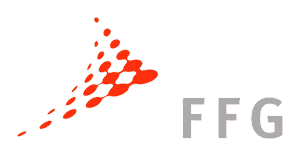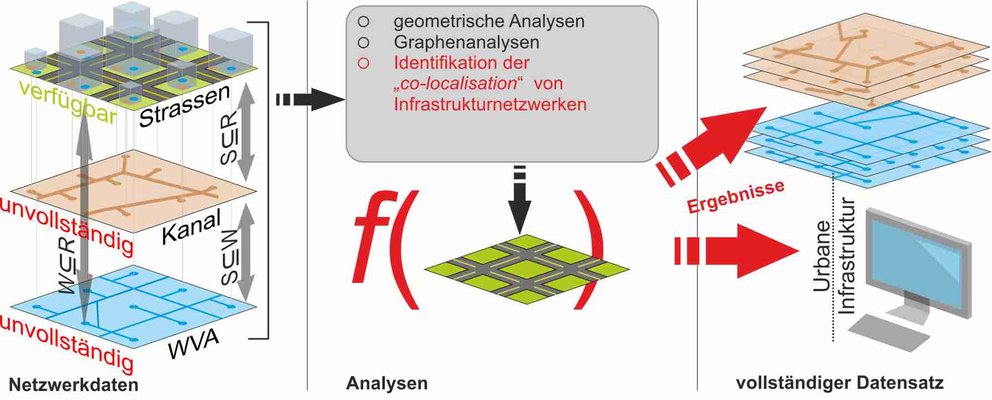Optimal pipe network modelling based on stochastic data augmentation and network structure uncertainties - ORONET
Funded by: Austrian Research Promotion Agency (FFG)

Project partner: Innsbrucker Kommunalbetriebe AG
Responsible persons: Robert Sitzenfrei, Jonatan Zischg, Markus Sitzmann, Michael Mair
Project duration: 02/2017 - 07/2019
Project goals:
The mathematical description of water supply networks and their hydraulic modelling is state of the art and is also becoming increasingly popular in practical applications. Nevertheless, the path from the basic data to the hydraulic model is often difficult. The reasons for this are inadequate data quality, incorrect or outdated information or the non-availability of data. Insufficient budgets for modelling then lead to pipe network models that can only poorly represent reality. Similarly, inadequately created hydraulic models reduce confidence in the forecasting ability of such tools and the application possibilities and economic potential are therefore far from being utilised.
The classic practical application of a hydraulic pipe network model is the verification of various load cases (e.g. in official procedures). However, an appropriately created and calibrated model is suitable for numerous other areas of application with a corresponding economic potential. It should be noted that different areas of application also represent different modelling objectives and therefore require a different level of data and measurement results. Modelling objectives can include
- Higher-level hydraulic analyses (pumping energy, water balance, emergency networks, etc.)
- Hydraulic verifications for specific load cases (e.g. in official procedures)
- Construction site planning and management
- Pipe burst detection and management as well as localisation of leaks
- Incident management, safety analyses and proactive emergency planning
- Investigation of network mergers, network expansion and adaptations
- Support for rehabilitation planning
- Optimisation of control systems (e.g. valve controls), pressure management
- Water quality analyses, origin and mixing of different waters
All these different modelling objectives require different basic data such as network structure, consumption data, pressure and flow measurements, water quality measurements, control data, etc. Basic data on the network structure is often only incompletely available for users (where is a pipe located and what is its diameter?). In the already successfully completed, basic research-oriented FWF project "DynaVIBe", a methodology for the stochastic supplementation of network structures and other basic data was developed, which is now to be tested for its practical suitability and for the application of various modelling objectives. For example, the extent of necessary grid and consumption data for various modelling objectives is to be determined and the extent to which these can be stochastically supplemented is to be tested. The type and scope of measurement data (pressure, flow, water quality, fittings, etc.) will also be systematically determined in line with the various modelling objectives, and an approach for the optimal selection of measurement points for different modelling objectives and data supplements will be developed.

Fig: Adapted from Mair et. al, (2017) (licence: CC BY 4.0) (access: http://www.mdpi.com/2073-4441/9/2/146)
The aim is to compare and contrast the effort required to determine the data with the effort required to determine the model and the effects on the model results (uncertainties). As a result, an optimised and cost-efficient approach can be found as a service for the respective desired modelling objectives and results. This can drastically reduce the modelling effort for medium-sized municipalities from months to a few weeks or days. If the proposed approach is successfully developed and validated, the economic and ecological benefits of hydraulic modelling as well as the optimisation of the network and operation can then be fully exploited by the users and the municipal public service supply can be made more efficient and cost-effective.
Articles in journals and conferences:
- Sitzenfrei, Robert; Zischg, Jonatan; Sitzmann, Markus; Rathnayaka, S.; Kodikara, J.; Bach, Peter M. (2017): Effects of Implementing Decentralised Water Supply Systems in Existing Centralised Systems. In: World Environmental and Water Resources Congress 2017: Hydraulics and Waterways and Water Distribution Systems Analysis. Reston: American Society of Civil Engineering (ASCE), pp. 692 - 702.
- Sitzenfrei, Robert; Zischg, Jonatan; Sitzmann, Markus; Bach, P.M. (2017): Impact of Hybrid Water Supply on the Centralised Water System. In: Water 9/11, No. 855 IF: 1.83
- Zischg, J.; Mair, M.; Rauch, W.; Sitzenfrei, R. (2017): Enabling Efficient and Sustainable Transitions of Water Distribution Systems under Network Structure Uncertainty. In: Water 9/9, No. 715. IF:1.83
- Zischg, Jonatan; Klinkhamer, C.; Zhan, X.; Ukkusuri, S.; Rao, P.S.C.; Rauch, Wolfgang; Sitzenfrei, Robert (2017): Evolution of Complex Network Topologies in Urban Water Infrastructure. In: World Environmental and Water Resources Congress 2017: Hydraulics and Waterways and Water Distribution Systems Analysis. Reston: American Society of Civil Engineering (ASCE), pp. 648 - 659.
- Zischg, J.; Rauch, W.; Sitzenfrei, R.; (2018): Morphogenesis of Urban Water Distribution Networks: A Spatiotemporal Planning Approach for Cost-Efficient and Reliable Supply. In: Entropy Vol. 20(9), p. 1 - 21 doi: 10.3390/e20090708 (peer reviewed) Impact factor 2.419 (2017)
- Zischg, J; Klinkhamer, C.; Zhan, X.; Rao, P.S.C.; Sitzenfrei, R.; (2019): A Century of Topological Co-Evolution of Complex Infrastructure Networks in an Alpine City. In: Complexity (peer reviewed) Impact factor 2.591 (2016)
- Zischg, J; Reyes-Silva, J.D.; Klinkhamer, C.; Krueger, E.; Krebs, P.; Rao, P. S. C. and Sitzenfrei, R.: (2019): Complex network analysis of water distribution systems in their dual representation using isolation valve information. In Proceedings of the World Environmental and Water Resources Congress 2019; Pittsburgh, Pennsylvania, United States, May 19-23, 2019
- Sitzenfrei, R.: Oberascher, M.; Zischg, J.: (2019): Identification of network patterns in optimal water distribution systems based on complex network analysis. In Proceedings of the World Environmental and Water Resources Congress 2019; Pittsburgh, Pennsylvania, United States, May 19-23, 2019.
